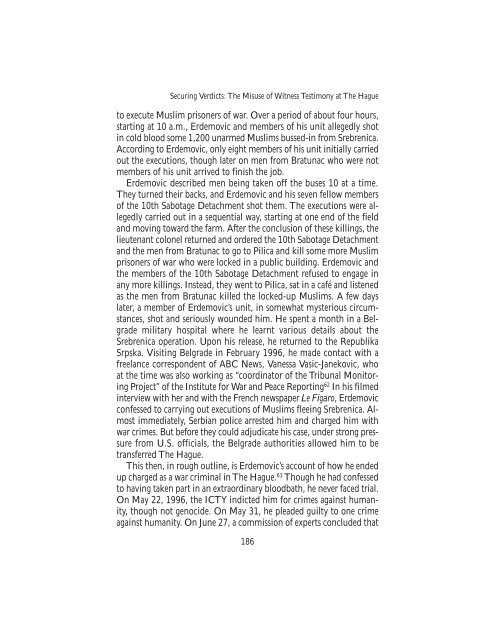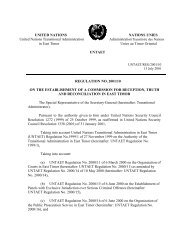The Srebrenica Massacre - Nova Srpska Politicka Misao
The Srebrenica Massacre - Nova Srpska Politicka Misao
The Srebrenica Massacre - Nova Srpska Politicka Misao
You also want an ePaper? Increase the reach of your titles
YUMPU automatically turns print PDFs into web optimized ePapers that Google loves.
Securing Verdicts: <strong>The</strong> Misuse of Witness Testimony at <strong>The</strong> Hague<br />
to execute Muslim prisoners of war. Over a period of about four hours,<br />
starting at 10 a.m., Erdemovic and members of his unit allegedly shot<br />
in cold blood some 1,200 unarmed Muslims bussed-in from <strong>Srebrenica</strong>.<br />
According to Erdemovic, only eight members of his unit initially carried<br />
out the executions, though later on men from Bratunac who were not<br />
members of his unit arrived to finish the job.<br />
Erdemovic described men being taken off the buses 10 at a time.<br />
<strong>The</strong>y turned their backs, and Erdemovic and his seven fellow members<br />
of the 10th Sabotage Detachment shot them. <strong>The</strong> executions were allegedly<br />
carried out in a sequential way, starting at one end of the field<br />
and moving toward the farm. After the conclusion of these killings, the<br />
lieutenant colonel returned and ordered the 10th Sabotage Detachment<br />
and the men from Bratunac to go to Pilica and kill some more Muslim<br />
prisoners of war who were locked in a public building. Erdemovic and<br />
the members of the 10th Sabotage Detachment refused to engage in<br />
any more killings. Instead, they went to Pilica, sat in a café and listened<br />
as the men from Bratunac killed the locked-up Muslims. A few days<br />
later, a member of Erdemovic’s unit, in somewhat mysterious circumstances,<br />
shot and seriously wounded him. He spent a month in a Belgrade<br />
military hospital where he learnt various details about the<br />
<strong>Srebrenica</strong> operation. Upon his release, he returned to the Republika<br />
<strong>Srpska</strong>. Visiting Belgrade in February 1996, he made contact with a<br />
freelance correspondent of ABC News, Vanessa Vasic-Janekovic, who<br />
at the time was also working as “coordinator of the Tribunal Monitoring<br />
Project” of the Institute for War and Peace Reporting 62 In his filmed<br />
interview with her and with the French newspaper Le Figaro, Erdemovic<br />
confessed to carrying out executions of Muslims fleeing <strong>Srebrenica</strong>. Almost<br />
immediately, Serbian police arrested him and charged him with<br />
war crimes. But before they could adjudicate his case, under strong pressure<br />
from U.S. officials, the Belgrade authorities allowed him to be<br />
transferred <strong>The</strong> Hague.<br />
This then, in rough outline, is Erdemovic’s account of how he ended<br />
up charged as a war criminal in <strong>The</strong> Hague. 63 Though he had confessed<br />
to having taken part in an extraordinary bloodbath, he never faced trial.<br />
On May 22, 1996, the ICTY indicted him for crimes against humanity,<br />
though not genocide. On May 31, he pleaded guilty to one crime<br />
against humanity. On June 27, a commission of experts concluded that<br />
186



